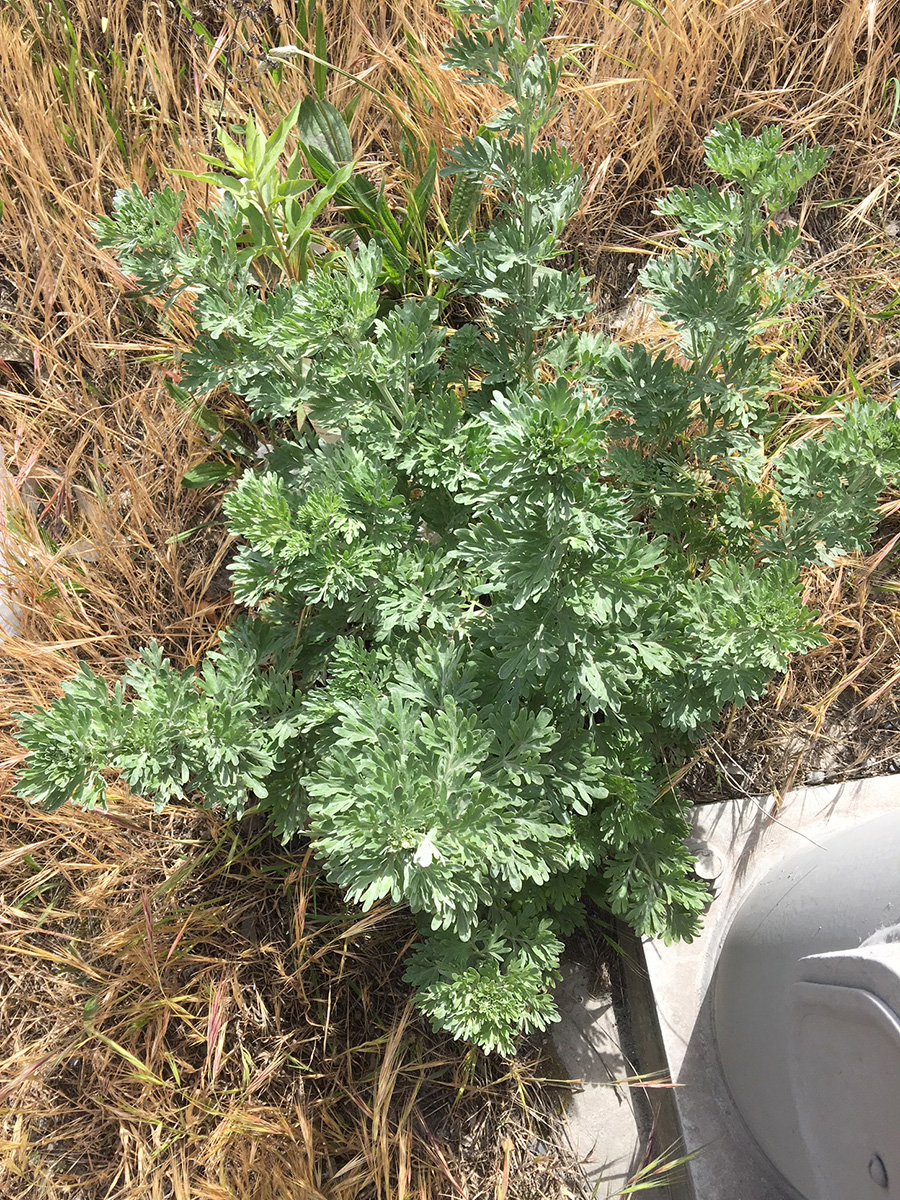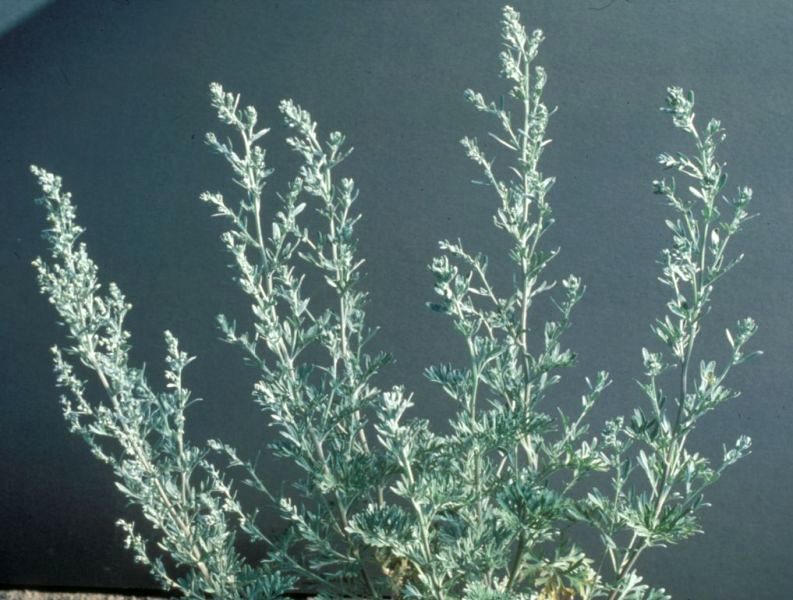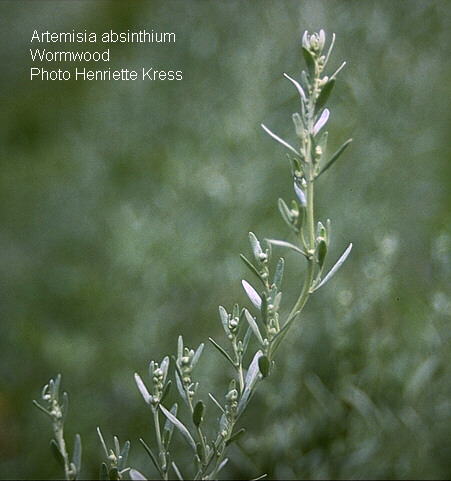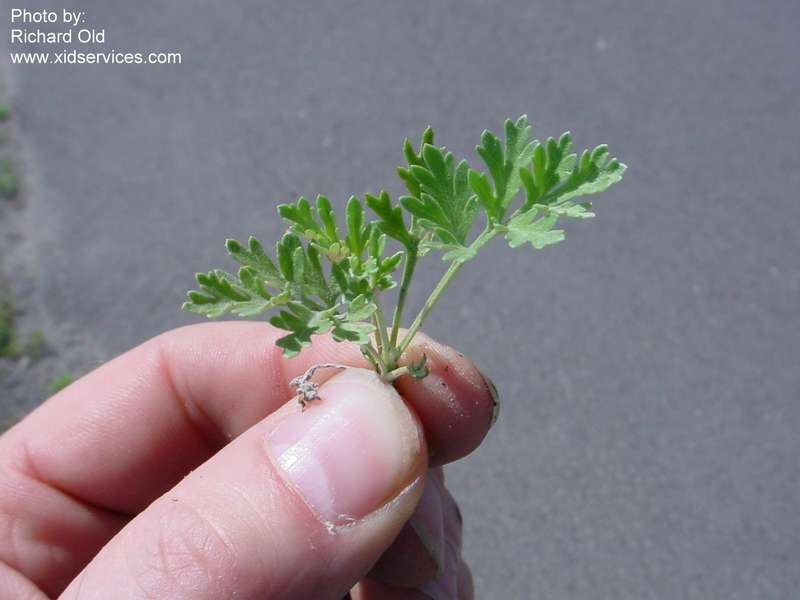Absinth wormwood identification and control
Artemisia absinthium, Asteraceae Family

Absinth wormwood (Artemisia absinthium) is a semi-woody, clump-forming perennial, native to parts of Europe and Asia, that resembles sage brush in appearance and odor. It is in the composite family but is most recognizable by its lacy, olive-green foliage covered with fine grey hairs. Most common on dry, open waste areas or overgrazed rangeland, but also present along roads and in pastures. Absinth wormwood is established across the United States and Canada. It can be found throughout Washington State, although it is most common east of the Cascades.
Absinth wormwood is mostly limited in distribution in King County to highway shoulders, a few county roads, and railroad rights-of-way. However, it is regularly re-introduced from eastern Washington by way of the highways and could potentially become a much bigger problem in King County. Once this plant gets established in a pasture or range area, it is very difficult to remove and can have significant impacts on the quality of forage for wildlife and livestock.
Legal Status in King County, Washington
Public and private landowners are required to control infestations of absinth wormwood on their property in King County, Washington. Absinth wormwood is a Class C Noxious Weed in Washington, first listed in 1988. It is selected for required control by the King County Noxious Weed Control Board and is on the list of Regulated Class C Noxious Weeds in King County. For more information, see Noxious weed lists and laws.
Identification (see below for additional photos)
- Strong unpleasant odor, similar to sage but not as nice
- Stems and leaves are usually covered with silky gray hairs, especially when young
- May appear greener and less hairy in moist or shady sites
- Stems are grooved and branched above
- Grows in clusters of several upright stems from one large woody taproot
- Plants are three to five feet tall, up to two feet wide
- Leaves are olive-green above, white below, covered with silky gray hairs, one to five inches long, divided one to two times and deeply lobed
- Leaves are spirally arranged on stem
- Flowers are small, yellowish, disc-shaped, nodding, and arranged in a leafy, spike like panicle at the top of the stems
- Lower stems and base of plant are often woody
- Flowers from July through September
- Look-alikes to absinth wormwood also found in western Washington:
- mugwort or common wormwood (Artemisia vulgaris) (external link)
- biennial wormwood (Artemisia biennis) (external link)
- field sagewort (Artemisia campestris) (external link)
- white sagebrush (Artemisia ludoviciana) (external link)
- coastal wormwood (Artemisia suksdorfii) (external link)
- common tansy (Tanacetum vulgare)


Toxicity
Although extracts of this plant are used in preparing the beverage absinthe, the plant is poisonous and no part of the plant should be ingested. Absinthe is banned from use in several countries and has been shown to disrupt the nervous system and may cause death when consumed in large enough quantities. On the good side, because of its toxic qualities, absinth wormwood works to deter insects and, reportedly, the leaves can be rubbed on the skin for an effective insect repellant.
Habitat and impact

Absinth wormwood causes economic losses in Washington State and elsewhere by reducing available forage in native and managed rangelands and pastures, tainting the milk of cattle that graze it, and contaminating grain. The pollen is a source of allergy and asthma problems. Also, absinth wormwood is allelopathic, inhibiting the growth of other plants. Volatile emissions from the leaves prevented wheat germination in one study. The entire plant is toxic if ingested.
It is found on both dry and moist sites but usually in well-drained soils. Most common in over-grazed pasture and rangeland, waste areas, fence rows, and roadsides. Occasionally used as a garden ornamental. Most often invades disturbed or over-grazed areas where there is little competition from other plant species but can be difficult to manage once established. Absinth wormwood is also known to out-compete desirable grasses and other plants in established pastures and native grasslands, reducing biodiversity and lowering forage quality.
Growth and reproduction
Absinth wormwood is an herbaceous perennial that reproduces primarily by small, easily scattered seeds, but that can also spread somewhat by lateral roots. Seeds are dispersed by wind, water, animals, hay, in soil and on equipment. It is a prolific seed producer with up to 50,000 seeds per stem. Seeds are generally viable for 3 to 4 years. The large taproot is woody and the plant re-grows from the ground level each spring. Seedlings emerge from late spring to early fall. Rosettes form by the end of the first growing season. Plants generally begin grow from late April or early May and begin to flower from late July to early August. Above-ground portion of the plant generally dies back in the late fall and the crown of the plant produces buds that give rise to new shoots each spring. Seedlings produce several small leaves close to the soil surface that may go unnoticed in areas with good grass cover.
Control
Prevention and cultural methods
To prevent the spread of absinth wormwood, minimize soil disturbance from vehicles and machinery, avoid over-grazing, and watch roadsides and fence rows for new populations. In pastures, a healthy stand of perennial grass will resist invasion and reduce spread of this plant. Disturbed areas should be re-seeded to prevent spread of absinth wormwood.
Manual control
For individual plants or small patches, hand pull or dig up the roots when the soil is moist, making sure to remove all the roots.
Mechanical methods
In crop production areas, tillage can prevent establishment. Summer fallow followed by fall tillage is more effective than spring tillage. Mowing can prevent seed production if done several times throughout the growing season, but is difficult in the types of areas this plant usually grows and will not generally reduce the size or density of the infestation unless other methods are used in combination with mowing.
Chemical control
Several herbicides are available for absinth wormwood control. Aminopyralid, clopyralid, dicamba, glyphosate and 2,4-D are effective for controlling absinth wormwood. Some products are limited to certain sites and land uses and may be restricted in some cases. Always read the label carefully to make sure the product is safe and appropriate for your site and intended land use and for recommended rates and timing for your site. Avoid spraying where there is a chance that herbicide will enter a waterway or wetland unless you are using a state-approved aquatic herbicide and have a permit and license to do so. Some local jurisdictions restrict herbicide use in certain areas, so make sure to refer to the local regulations regarding herbicide use. For best results, spray the foliage and stems of actively growing plants when they are at least 12 inches tall. Better control of the following year's seedlings is achieved when herbicides are applied to the infested area from late June to mid-August. For fall treatments, mow in early to mid summer first to promote active regrowth in the fall. Use of a spreader-sticker (surfactant) is essential due to the fine hairs covering the plant.
Disposal of plant material
In order to prevent spreading seeds, plants with flowers or seeds should not be placed in compost bins or yard waste piles and should not be burned. Instead, place in a bag and dispose of in the garbage. Plants without flowers can be left on site or disposed of with other yard waste, as long as livestock do not have access to it.
For more information or a site-specific recommendation in King County, Washington, contact the noxious weed program. For information in other locations, contact your local weed board or extension office.
Additional information on absinth wormwood
- Washington State Noxious Weed Board (external link)
- Absinth Wormwood: Options for Control, Lincoln County Noxious Weed Board (external link)
- University of Washington Burke Museum Herbarium Image Collection - Artemisia absinthium (external link)
- Google Images for Artemisia absinithium (external link)
- CalPhotos for Artemisia absinthium (external link)
- North Dakota Factsheet on Absinth Wormwood (external link)
What to do if you find this plant in King County, Washington
Please notify us if you see absinth wormwood growing in King County. Our program staff can provide the property owner or appropriate public agency with site-specific advice on how best to remove it. Also, because absinth wormwood is still found in only a few places in the county, we have an opportunity to stop it from spreading if we act quickly. We map all known locations of regulated noxious weeds such as absinth wormwood in order to help us and others locate new infestations in time to control them.
Absinth wormwood photos












Report absinth wormwood in King County, Washington
- Please notify us through our online infestation form
Locate absinth wormwood in King County, Washington
- Use our interactive noxious weed map and search
for absinth wormwood
Related information
Related agencies
Program offices are located at 201 S. Jackson St., Suite 600, Seattle, WA 98104. To contact staff, see the Noxious Weed Control Program Directory, send an email, or call 206-477-WEED (206-477-9333).

 Translate
Translate